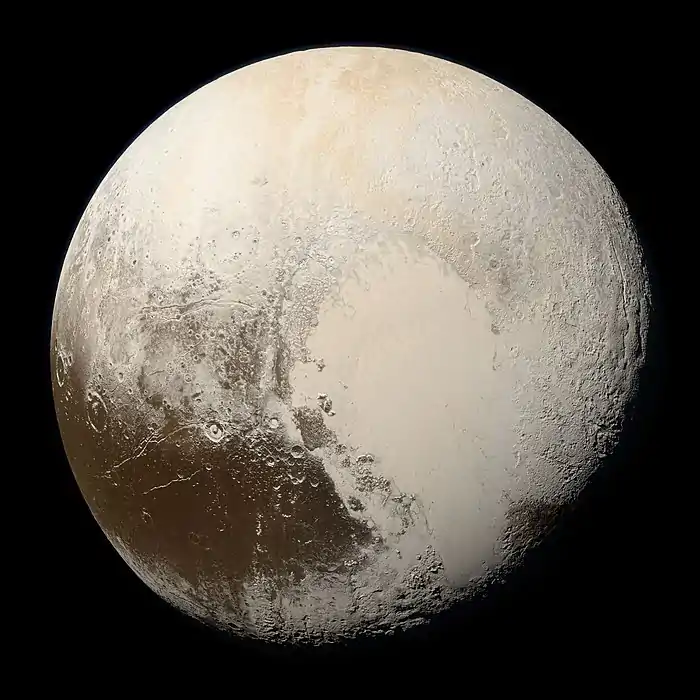1995 SN55
1995 SN55, is a minor planet and likely centaur that orbits in the outer Solar System beyond the orbit of Jupiter. With an estimated diameter of approximately 290 kilometers (180 miles), it would be one of the largest centaurs. First observed by Spacewatch in 1995, it is now a lost minor planet with an insufficiently defined orbit from only 7 weeks of observations, and it has not been observed since.[4] This is in part because its first announcement was delayed until June 1999, by which point the orbital uncertainty was already around 1 degree.[1]
| Discovery [1] | |
|---|---|
| Discovered by | Spacewatch N. M. Danzl A. E. Gleason |
| Discovery site | Kitt Peak Obs. |
| Discovery date | 20 September 1995 (discovery: first observed only) |
| Designations | |
| 1995 SN55 | |
| centaur [2][3] · distant [4] | |
| Orbital characteristics [2] | |
| Epoch 6 October 1995 (JD 2449996.5) | |
| Uncertainty parameter 9[2] · E[4] | |
| Observation arc | 36 days |
| Aphelion | 39.2±2.2 AU |
| Perihelion | 7.9±3.4 AU |
| 23.6±1.3 AU | |
| Eccentricity | 0.66±0.12 |
| 114.4±9.5 yr (41800±3500 d) | |
| 180°±46° | |
| 0° 0m (31.0 ± 2.5)s / day | |
| Inclination | 4.97°±0.34° |
| 140.3°±5.6° | |
| 53°±14° | |
| Physical characteristics | |
Mean diameter | 280 km[3] 290 km[5] 300 km (est. at 6.0; 0.08)[6] |
| 0.078 (assumed)[7] 0.08 (assumed)[5][8] | |
| 6.0±0.4[4][2] · 6.2[5] | |
Observations
| Date | Uncertainty in distance from the Sun |
|---|---|
| 1995-Sep | ±350 million km |
| 1999-Jul | ±500 million km |
| 2004-Aug | ±1 billion km |
| 2013-Mar | ±2 billion km |
| 2020-Aug | ±3 billion km |
| 2027-Jan | ±4 billion km |
| 2032-May | ±5 billion km |
First observation and loss
1995 SN55 was about 39 AU from the Sun when it was first observed in 1995, by astronomers Nichole Danzl and Arianna Gleason of the Spacewatch survey at Kitt Peak Observatory in Arizona, United States.[9][4] It was only observed 14 times over 36 days, from 20 September to 26 October 1995.[2][10] The discovery observations of 1995 SN55 were published and announced by the Minor Planet Center on 11 June 1999.[1]
Recovery attempts
There have been numerous failed attempts to recover 1995 SN55, the most recent in 2018. The failure at recovery indicates it is either dimmer than expected, or on a different orbit than calculated. As of August 2020, the uncertainty in the heliocentric distance is ±3.0 billion km (±20 AU).
Classification and orbit
Centaurs have a perihelion greater than Jupiter's and a semi-major axis less than that of Neptune. 1995 SN55 orbits the Sun at a distance of 7.9–39.2 AU once every 114 years and 5 months (41,782 days). Its orbit has an eccentricity of 0.66 and an inclination of 5° with respect to the ecliptic.[2] Due to this short observation arc , the object has a very poorly known orbit with the highest possible uncertainty parameter value of 9 and is considered a lost minor planet.
JPL's Small-Body Database shows this object having an aphelion distance of 39.2 AU,[2] whereas the Deep Ecliptic Survey (DES) finds an aphelion distance of 91 AU,[10] which would make it a trans-Neptunian object by JPL's orbital classification (hence the uncertainty whether 1995 SN55 is a centaur at all).
Physical characteristics
If confirmed to be a centaur, 1995 SN55 would be one of the largest centaurs known with an diameter estimate of 280 and 290 kilometers (174 and 180 miles).[3][5] Based on a generic magnitude-to-diameter conversion, 1995 SN55 could measure 300 kilometers,[6] using an observed absolute magnitude of 6.0,[2] and an albedo of 0.08, which is typically assumed for centaurs.[5][7][8] The two largest known centaurs are 10199 Chariklo (250 km) and 2060 Chiron (220 km). These two bodies have an absolute magnitude of 7.40 and 6.2, as well as an albedo of 0.035 and 0.07, respectively. The body's rotation period, shape and spin axes remain unknown.[11]
Numbering and naming
Due to its uncertain orbit, this minor planet has not been numbered. A numbering and subsequent naming will only be considered upon its rediscovery.
References
- "MPEC 1999-L25 : 1995 SN55, 1998 TF35". Minor Planet Electronic Circular. Minor Planet Center. 11 June 1999. Retrieved 30 November 2020.
- "JPL Small-Body Database Browser: (1995 SN55)" (1995-10-26 last obs.). Jet Propulsion Laboratory. Archived from the original on 12 December 2012. Retrieved 30 July 2017.
- "List of Known Trans-Neptunian Objects (incl. centaurs)". Johnston's Archive. 22 July 2017. Retrieved 7 September 2017.
- "1995 SN55". Minor Planet Center. Retrieved 30 July 2017.
- Michael E. Brown. "How many dwarf planets are there in the outer solar system? (updates daily)". California Institute of Technology. Retrieved 7 September 2017.
- "Asteroid Size Estimator". CNEOS/JPL. Retrieved 7 September 2017.
- "TNO/Centaur diameters and albedos". Johnston's Archive. 5 September 2016. Retrieved 7 September 2017.
- Bauer, James M.; Grav, T.; Mainzer, A. K.; Masiero, J. R.; Blauvelt, E.; Stevenson, R.; et al. (October 2013). "Centaurs and Scattered Disk Objects in the Thermal Infrared: Analysis of WISE/NEOWISE Observations". American Astronomical Society. 773 (1): 22. arXiv:1306.1862. Bibcode:2013DPS....4550806B. doi:10.1088/0004-637X/773/1/22. S2CID 51139703.
- "List Of Centaurs and Scattered-Disk Objects". Minor Planet Center. Retrieved 21 October 2008.
- Marc W. Buie (26 October 1995). "Orbit Fit and Astrometric record for 95SN55". SwRI (Space Science Department). Retrieved 21 October 2008.
- "LCDB Data for (1995)". Asteroid Lightcurve Database (LCDB). Retrieved 30 July 2017.
External links
- 1995 SN55 at www.aerith.net
- 1995 SN55 at the JPL Small-Body Database

_(cropped).jpg.webp)
